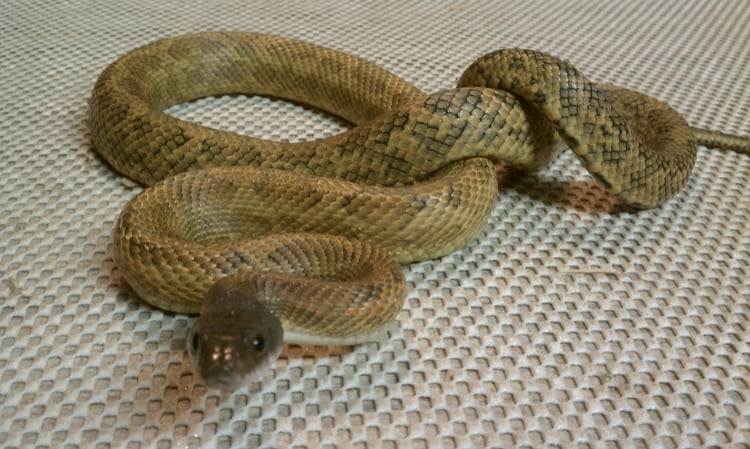I've spent a great deal more time analyzing this year's hatchlings and I now think that I know what defines my morph. So, let's review some of last year's snakes (in no particular order) to test what we've learned:
(if this is your first visit, you might want to read earlier posts to figure out what I'm talking about)
16-02-07
This 2016 hatchling photo is pretty bad but you can see the broken eye stripe and severely distorted dorsal pattern which should indicate my cadmium morph.
Same snake, one year later and the dorsal pattern is gun metal grey instead of charcoal black and the ground color is very yellow with a silver wash. This is my cadmium morph.
This one had a fairly solid stripe through the eye and a mostly regular dorsal pattern. Many of the dorsal spots are washed out in the center but on the surface this looks like a typical rat snake.
One year later and the ground color is very yellowish but here's a trick. If you look at the white appearing between the scales along the back you realize that it forms two longitudinal stripes from head to tail that appear to be hidden under the scales and other colors. This is an indicator of a typical rat snake!
16-02-01
2016; solid stripe through the eye but the dorsal pattern is questionable. IMHO, it's not broken up enough. Should be a typical rat snake.
There's those hidden white stripes again. Based on the weird ground color, I don't doubt this animal will be cool looking but I'm putting this in the typical yellow/orange range. We'll know how yellow in another year.
16-01-01
Now, here's a little guy with a good example of a broken pattern. See how the dorsal markings look like jaguar spots? They are irregularly shaped, washed out in the center and often alternating along the axial line of the body? This will be a morph.
That's what I'm talking about. Morph city!
16-04-01
This little guy caught my eye when it hatched. The dorsal markings are oddly defined. Nice crisp dark outlines; fading slightly at their centers. The ground color is weirdly uniform. It looks cartoonish. If you stare at nature for very long you realize that most of it is fairly pixelated. This is why distant objects fade to blue in the atmosphere and caterpillars seem fuzzy. Our eyes are only designed to see so much detail so when something stands out as being sharply defined we tend to notice it.
year 1: the colors have changed but the contrast stays the same. You can barely make out the white longitudinal striping. I know that this is a typical rat snake but if you look closely at the scales you'll find that a normal snake's has many tiny specs of color on each scale. This snake has noticeably fewer. What a neat aberration. I wish I could get a good pic of this.
16-05-05
Typical, normal, boring rat snake. Oh how I long for the unique and freaky fashions of the recessive types.
other than a light ground color and a nice prevalent longitudinal white stripe, who cares?
16-05-04
If you've been paying attention than you'll see that this snake might be something cool.
Hey! Look at that! The dorsal pattern is fading out already, there's a nice silvery color filling in between them. The only note is that the longitudinal white stripe is pretty clear on this animal. Maybe I'm making too much of the white stripe.
16-05-03
Perfect example of the "jaguar spot" comment I made earlier. Specifically look at the contrast between light and dark on the tail andcompare it to the middle of the body.
Every time I see one like this I go back and look at the pics I've posted of typical rat snakes. Consider that we're one mis-folded protein away from a zombie apocalypse and then think about how lucky you have to be to get this shift in patterns and colors.
16-05-01
:eyeroll: Another boring, stupid, boring, normal, boring, everyday snake just like the ones that get in to your attic and eat the squirrels.
I spend my hard earned $$ to feed this run-of-the-mill animal and then come home after a long day at work to clean its cage! Why, I ask you?
16-01-03
Hey now! Here's a keeper!
compare the solid dorsal markings on this animal to the ones from the previous snake. These are deeply concave. They look like thick X's or hour glasses. The previous snake's dorsal markings are weakly concave and look like more like saddles.
16-06-03
Lots of nice colors and contrasts on this one but...solid eye strip and uniform dorsal markings. If you've been paying attention, you know what I think of this one.
Let me be the first to say that this is a gorgeous yellow phase Texas rat snake. In this pic, you can see the grey color on the center line and tips of the yellow scales, you can make out the longitudinal white stripes, and (my personal favorite trait) there is a copper color appearing on the nose. The neck & tail have developed more bright orange while the center of the body is much lighter. Even the eyes have a striking quality.
16-03-02
Broken head stripes: check
Broken dorsal patterns: check
Lets see how this plays out.
Well, what do you know. I think I've figured out what I'm talking about, finally.
Over the next 2-3 years these snakes will get more colorful, and uniquely patterned. Sometime around 7-10 years old they will get darker and less vibrant. Such is the way of reptilian coloration.
























